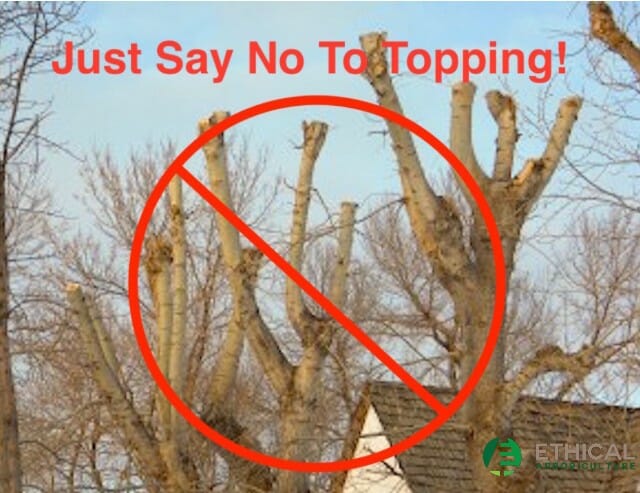Topping is perhaps the most harmful tree pruning practice known. Yet, despite more than 25 years of literature and seminars explaining its harmful effects, topping remains a common practice.
Topping is often used to reduce the size of a tree. A homeowner may feel that a tree has become too large for his or her property, or that tall trees may pose an unacceptable risk.
Topping, however, is not a viable method of height reduction and certainly
does not reduce future risk. In fact, topping will increase risk in the long term.

Topping Stresses Trees
Topping can remove 50 to 100 percent of a tree’s leaf-bearing crown. Leaves are the food factories of a tree. Removing them can temporarily starve a tree and trigger various survival mechanisms. Dormant buds are activated, forcing the rapid growth of multiple shoots below each cut. The tree needs to put out a new crop of leaves as soon as possible. If a tree does not have the stored energy reserves to do so, it will be seriously
weakened and may die.
A stressed tree with large, open pruning wounds is more vulnerable to insect and disease infestations. The tree may lack sufficient energy to chemically defend the
wounds against invasion, and some insects are actually attracted to the chemical signals trees release.
Topping Leads to Decay
Correct pruning cuts are made just beyond the branch collar at the
point of attachment.
The tree is biologically equipped to close such a wound, provided the tree is healthy
enough and the wound is not too large. Cuts made indiscriminately between lateral branches create stubs or wounds that the tree may not be able to close. The exposed wood tissues begin to decay. Normally, a tree will “wall off,” or compartmentalize, the decaying tissues, but few trees can defend against the multiple severe wounds caused by topping.
Topping increases risk
The survival mechanism that causes a tree to produce multiple shoots below each topping cut comes at great expense to the tree. These shoots develop from buds near
the surface of the old branches. Unlike normal branches that develop in a socket of overlapping wood tissues, these new shoots are anchored only in the outermost layers of
the parent branches and are weakly attached.
The new shoots grow quickly, as much as 20 feet (6 m) in one year in some
species. Unfortunately, the shoots are prone to breaking, especially during
windy or icy conditions.
While the original goal was to reduce risk by reducing height, risk of limb failure
has now increased.
Topping is expensive
The cost of topping a tree is not limited to only the job cost. Some hidden costs of topping include:
• Increased maintenance costs. If the tree survives, it will likely require corrective pruning within a few years (e.g., crown reduction or storm damage repair). If the tree dies, it will have to be removed.
• Reduced property value. Healthy, well-maintained trees can add 10 to 20 percent to the value of a property. Disfigured, topped trees are considered an impending expense.
• Increased liability potential. Topped trees may pose an unacceptable level of risk. Because topping is considered an unacceptable pruning practice, any damage caused by branch failure of a topped tree may lead to a finding of negligence in a court of law